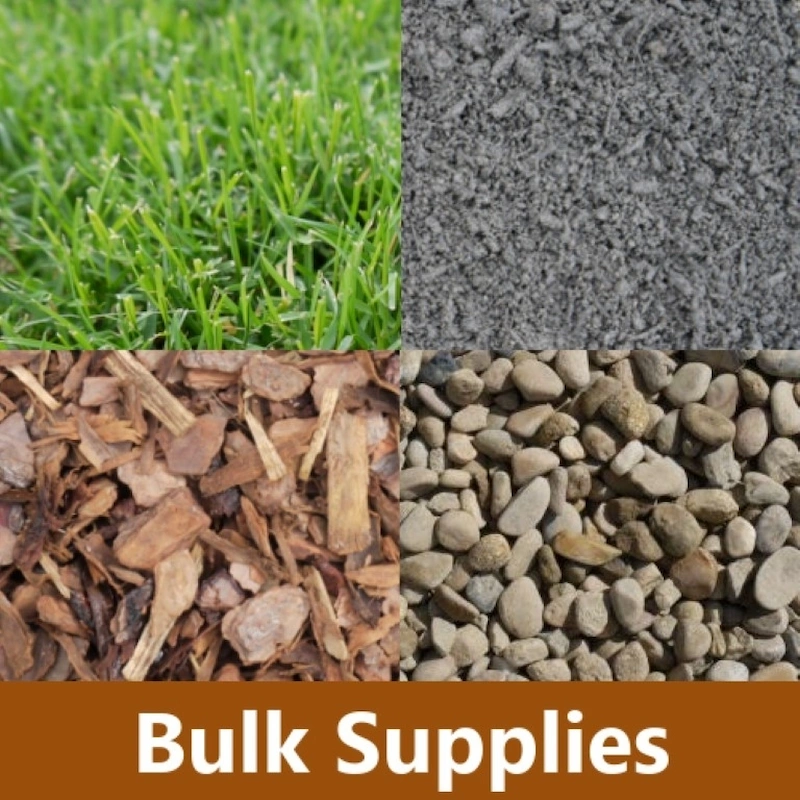
How to Choose, Estimate, and Order Landscaping Supplies in the Okanagan
Planning a yard refresh or a larger site makeover? The right landscaping supplies make the difference between a tidy, low-maintenance finish and a project that needs constant rework. This guide walks you through a professional approach to selecting materials, estimating accurate quantities, and staging deliveries so your project runs smoothly from start to finish—tailored to Okanagan soil, slope, and climate conditions.
1) Start With the Site: Soil, Slope, Sun, and Use
- Soil: Grab a handful. If it balls tight and stays sticky, you’ve got clay; if it falls apart, you’re sandy. Clay benefits from compost and structure; sand needs organic matter for water holding.
- Slope & drainage: Watch where water collects after a rain. Low areas may need re-grading, French drains, or a coarser base layer to move water away from structures.
- Sun & wind: South- and west-facing areas dry out faster—plan for mulch and drought-tolerant planting or rock features.
- Foot traffic: Paths, play zones, and parking need compacted base aggregates; beds and tree rings need breathable organics.
2) Match Materials to Goals (Not Trends)
Every product has a purpose. Shop by performance first, looks second:
- Compost & soil blends build plant health. Use as an amendment or for the top layer under sod/seed.
- Mulches (bark or composted) protect soil, buffer temperatures, and suppress weeds in beds.
- Base aggregates (e.g., 3/4″ road crush) compact to a stable platform for patios, walks, and drives.
- Clear/drain rock lets water pass through. Use around perforated pipe, dry wells, or behind retaining structures.
- Decorative rock finishes xeriscape and accents. It’s low maintenance but still needs proper underlayment.
- Geotextile fabrics separate layers and reduce mixing. Use non-woven under rock and in drains; avoid plastic sheeting in plant beds.
3) Estimating Quantities (With Pro-Level Accuracy)
The simplest way to estimate bulk materials is with this formula:
Cubic yards = (Area in sq ft × Depth in inches) ÷ 324
Why 324? One yard is 27 cubic feet; depth in inches ÷ 12 converts to feet; so (sq ft × depth/12) ÷ 27 = sq ft × depth ÷ 324.
Typical Depth Guidelines
- Mulch in planting beds: 2–3 in.
- Compost topdress (to blend into soil): 1–2 in.
- Topsoil under sod/seed (over a compacted base): 3–6 in.
- Patio/Walk base aggregate: 4–6 in. (more for clay or vehicle traffic)
- Drive base aggregate: 6–8 in. plus periodic re-sheeting
- Decorative rock: 1.5–2 in. (use matching edging/curb)
- French drain trench: as specified, often 8–12 in. wide × 12–18 in. deep with fabric wrap
Three Worked Examples
- Garden bed refresh: 6 × 12 ft = 72 sq ft at 3 in. mulch → 72 × 3 ÷ 324 = 0.67 yd³. Round up to 1 yd³ to account for settling and edging.
- Patio base: 12 × 20 ft = 240 sq ft at 6 in. base → 240 × 6 ÷ 324 = 4.44 yd³. Add 10% for compaction and shaping → about 4.9 yd³. Bedding sand at 1 in.: 240 × 1 ÷ 324 = 0.74 yd³.
- French drain: 50 ft long × 1 ft wide × 1 ft deep = 50 cu ft = 1.85 yd³ of drain rock. Add fabric and a bit extra for transitions → order 2 yd³.
4) Weights, Trailers, and Access (Safety First)
Moisture and gradation change weight, but these ballparks help with logistics:
- Mulch/compost: roughly 400–1,000 lb/yd³
- Topsoil/garden soil: roughly 1,800–2,200 lb/yd³
- Sand/road crush/drain rock: roughly 2,600–3,000 lb/yd³
Check your vehicle’s payload/GVWR, use a covered or tarped load, and stage plywood or mats to protect driveways, curbs, and pavers at the drop point.
5) Quality Checks That Save Rework
- Screening size & fines: Confirm “minus” products (e.g., 3/4″ minus) for compaction and “clear” when you want drainage.
- Contamination: Ask about debris, salts, or over-fines that hold water. Request a clean, consistent spec—especially for visible finishes.
- Moisture & stability: Damp is fine; soupy loads are not. Aggregates should lock under compaction without pumping.
- Soil/compost maturity: Mature compost smells earthy, not sour; blended soils should crumble, not smear like clay.
6) Water-Wise Choices for Okanagan Yards
Hot, dry summers reward designs that reduce irrigation and protect soil:
- Mulch first, plant second: Set irrigation, spread mulch, then slit and plant—less disturbance and better coverage.
- Rock where you don’t water: Use decorative stone in sun-baked strips, curb islands, and edges prone to runoff.
- Right plant, right place: Group plants by water needs; keep turf compact and functional rather than sprawling.
- Edge control: Steel or concrete curb keeps mulch and rock in bounds and reduces top-ups.
7) Fabric, Edging, and the Weed Question
Weed barriers can help—or hinder—depending on placement.
- Use non-woven geotextile under decorative rock to separate soil and reduce mixing. Overlap seams 8–12 in.
- Avoid plastic sheet that blocks air/water in planted beds; mulch plus regular top-ups is healthier for soil life.
- Edging matters more than fabric in many beds. A crisp edge and 2–3 in. of fresh mulch is your best weed defense.
8) Sequencing and Staging Deliveries
- Rough grade: Shape and compact subgrade; fix drainage first.
- Base layers: Deliver base aggregates, compact in lifts (2–3 in.).
- Structural elements: Set curbs, edging, and walls so finish materials have a hard boundary.
- Finish materials: Bring in soil, mulch, rock. Place from back to front to avoid tracking.
For tight sites, schedule split loads: base first, then finishes. Keep stockpiles tidy and covered if rain is forecast.
9) Common Mistakes (and Easy Fixes)
- Too little depth: 1 inch of mulch won’t suppress weeds—go 2–3 in. and renew annually where wind/exposure erodes cover.
- Wrong rock for the job: “Clear” under patios leads to settling; use “minus” for compaction and clear only where you want drainage.
- Skipping compaction: Every 2–3 in., compact until it resists footprints. Under-compacted base telegraphs to the surface.
- No separation: Rock without fabric migrates into soil; soil without edging washes into paths. Separate layers and define edges.
10) Sustainable Choices That Also Save Money
- Recycled aggregates: Crushed concrete/asphalt is ideal for many bases and keeps material out of landfill.
- Keep waste streams clean: Separate green waste from soil and rock—it lowers disposal cost and enables recycling.
- Consolidate deliveries: One well-planned truck beats multiple small trips—for your budget and the environment.
Pro Tip: A Mini Glossary for Ordering
- Minus: Aggregate with fines that compacts (e.g., 3/4″ minus).
- Clear: Washed stone without fines for drainage (e.g., 3/4″ clear).
- Crush: Angular rock that interlocks better than round stone.
- Topdress: A thin layer added to the surface (soil or compost for lawns; mulch for beds).
- Lift: A compacted layer thickness (2–3 in. is common for base work).
Ready to Build?
With an honest site assessment, correct materials, and accurate quantities, your project will look better and last longer. Map the area, choose the right depth, calculate yards with the 324 formula, and stage deliveries to match your sequence. If you need help reconciling specs, selecting a mulch colour, or deciding between “minus” and “clear” for a particular area, talk to a local supplier who works with Okanagan conditions day in and day out. A five-minute conversation can save you a return trip and a weekend of rework.
